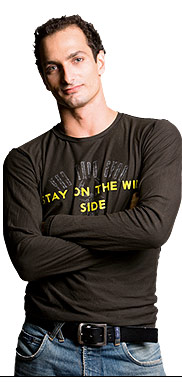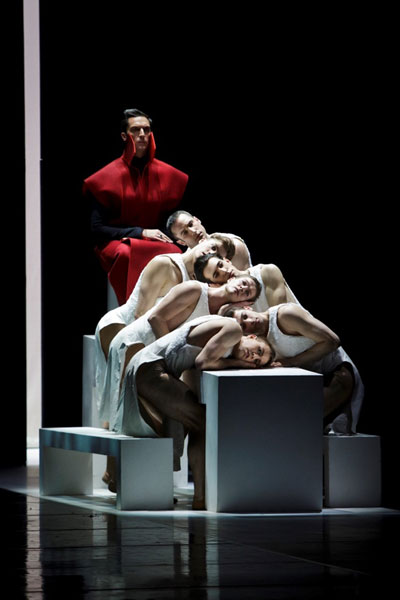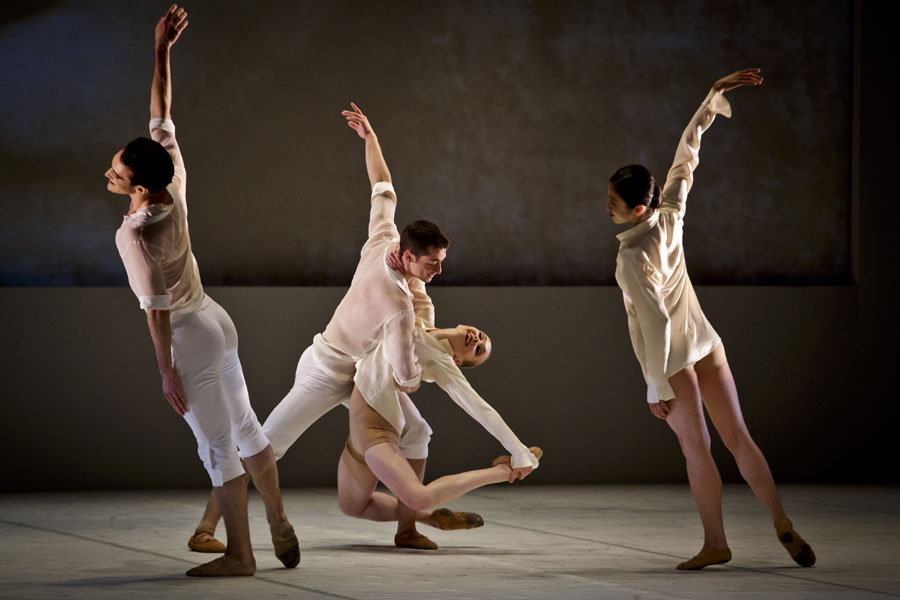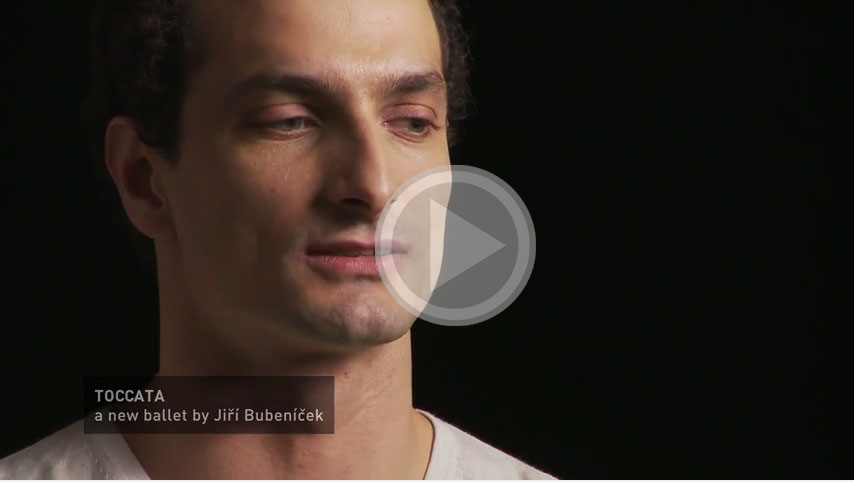Join the ICONS
Dance ICONS is a global network for choreographers of all levels of experience, nationalities, and genres. We offer a cloud-based platform for knowledge exchange, collaboration, inspiration, and debate. Dance ICONS is based in Washington, D.C., and serves choreographers the world over.
Subscribe today to receive our news and updates. Become a member of your global artistic community -- join the ICONS!
JIRI BUBENICEK: BROTHERLY LOVE AND CHOREOGRAPHY
 You might have to look twice walking into a studio when Czech-born choreographer Jiri Bubeníček is at work, especially when his brother Otto is around. The twin ballet dancing brothers, of course, grew up together. They joined the Hamburg Ballet together, where they both dance innumerable solo roles by resident choreographer John Neumeier.
You might have to look twice walking into a studio when Czech-born choreographer Jiri Bubeníček is at work, especially when his brother Otto is around. The twin ballet dancing brothers, of course, grew up together. They joined the Hamburg Ballet together, where they both dance innumerable solo roles by resident choreographer John Neumeier.
Today the brothers still work together more closely than ever as collaborative artistic partners. Jiri is the choreographer and Otto, the designer, composer, dramaturg and all-around artistic advisor and eagle eye. When one of them talks about their work, it is always in first-person plural: “we.” ICONS Inspire caught up with Jiri, as his brother chimed in occasionally from out-of-Skype camera range, in April, just before the premiere of his full-evening work Dr. Zhivago.
A Czech citizen, born in Lubin in 1974, Jiri and Otto were sons of circus acrobats and their childhood was spent touring Europe and abroad during the Communist era. They studied dance at the Prague Dance Conservatory, and in 1992, Jiri received an award at the Prix de Lausanne, an international competition for young dancers. He made his professional debut in 1993 with John Neumeier’s Hamburg Ballet. There he was promoted to soloist in 1995 and then Principal Dancer in 1997. Neumeier created the Vaclav Nijinsky role in the critically acclaimed Nijinsky especially for Jiří and it has toured all over the world. In 2006, Jiri Bubeníček joined the Semperoper Ballet in Dresden, Germany, and guested with companies including the Paris Opera Ballet where he partnered Aurelie Dupont and Agnes Letestu.
Jiří retired from performing in the fall of 2015, dancing Kenneth McMillan’s Manon as his last ballet. These days he spends his time in the studio choreographing, or traveling and setting his works on companies around the world.
His choreography includes: “Toccata” for New York City Ballet; “Le Souffle de l´Esprit” for Zurich Ballet, later staged for Manuel Legris’ Vienna State Ballet, and North Carolina Dance Theater; “Unerreichbare Orte” for Hamburg Ballet, “Die Innere Stimme” for Dresden Semperoper Ballet, “Outrenoir” for China National Ballet, “Graffity” for Laterna Magika in Prague and others.
Since 2009 the brothers have collaborated on performances that they have called Bubeníček Ballet World and Les Ballets Bubeníček. These programs feature works created by the brothers, presenting Jiří’s choreographies and Otto’s stage and costume designs and music. In 2005, TV Arte made a documentary film about Jiří and his twin brother Otto called “Die Ballett-Zwillinge” (“The Ballet Twins”). In April 2016, Jiří’s newest work, a full-length Dr. Zhivago, created with brother Otto, had its world premiere at the Slovenian National Opera and Ballet Theatre.
 ICONS: You come from family of circus acrobats. Tell us about how you started dancing.
ICONS: You come from family of circus acrobats. Tell us about how you started dancing.
JB: Yes. We both had the same interests as brothers. We wanted to be acrobats like our parents and we loved the circus. My parents were very successful and as kids we traveled around with them. In the Communist era, when we were about 8, 9, 10, we saw the West and we saw how people lived in the West. That made us start to feel how different the world was outside the Communist world.
Once we were rehearsing in a center for athletes and a ballet teacher was working there. She came to my father – we were about 10 years old – and said we should come to her school. When we first arrived, we cried about it. We didn’t want to dance; we wanted to stay in the circus because it was a fantastic life -- it always was outside. As a kid I didn’t understand how people could live in the city. My dad said, ‘Well, try it. Maybe it’s a good combination because you will learn how to use your body and present yourself and maybe you will like it … at least give it a try.’
We did and we were very lucky because we had a excellent ballet master – he was something of a Jedi for us. He was a very old man and … he was very serious, but he was also the opposite. He was also very funny, but he taught us discipline!
We learned to be very serious. We started with a class of about 11 boys and suddenly we realized that maybe this is good for our future and we began to take it seriously. After about a month or two we said, that’s it. We didn’t want to do anything else.
ICONS: You had a very full career as a dancer. What did you learn that is useful for you as a choreographer?
JB: The first thing [is] if you want to learn choreography, go and observe it. I was in Hamburg Ballet with John Neumeier for 13 years, from 1993 to 2006. I loved it, learned a lot. I went to [the Semperoper Ballet in] Dresden because I wanted to develop my skills as a choreographer. I worked with choreographers like William Forsythe, Jiri Kylian, Mats Ek, David Dawson. I just wanted to learn how choreographers think and how they work.
I wanted to meet those people and feel [their works] as a dancer. As a dancer working with them in the studio, I realized this is what I want to do. I wanted to see how Kylian works with people, how he treats them as human beings. I’m not a choreographer who just screams at [dancers] to do this.… Kylian or Forsythe or Mats Ek, they always respect you as a human. They find the humanity of it, the love, the soul … everything you would like to be respected for as a human. And, of course, if you are respected then you want to give more. I wanted to have this experience.

Le Souffle de l'Esprit, photo by Ek.
ICONS: When did you discover that passion for choreography? When did you know you wanted to make dances?
JB: For me it started slowly. I had already performed in school a dance that I made in my style. Then, maybe 10, 15 years ago when I was in Hamburg, I had not been cast, so I went to the studio and a friend of mine was also there. His passion was singing chansons. I would sometimes see his rehearsals when he was singing. I said, ‘Sasha, I could choreograph something for you for this song.’ He said, ‘If you say you’re going to do something, then do it.’ So I choreographed a solo. It was successful and then I ended up doing competitions and people began asking me to do more. I got my first commission in ’99 and since then it just happened naturally. I did solos, duets, trios. I just finished a full-length, two-act ballet. It took me about 15 years to get here.
ICONS: What do you do when you get stuck as a choreographer?
JB: It happens to every creator. It happens to me, but I’m lucky. I have a twin brother. I’m good with steps and I’m good with dramaturgy usually, but sometimes I get stuck. Then I call my brother and say, ‘Can you please come to the studio and help with some ideas?’ He has a special talent for this. He tells me what works, and what doesn’t. This is not real, this is real. So I have a fresh eye and that helps me.
But it’s also not easy to have a brother who is the exact same age, who is always around. We’re 41 years old, so it’s like being married for 41 years. Somehow, maybe because we went through the same kind of emotional things, we were both in ballet, we were both very creative, that’s given us similar tastes. He helps me with stage design and costumes … if you plan a [major] production, usually the stage design or costumes has to be ready a half year before you start choreographing. Somehow we really complete ourselves … in the end we have the same taste and I know we are both very lucky.
ICONS: What advice would you give to someone who wants to develop as a choreographer?
JB: I would tell them there’s no time to wait in life. There’s always some demonstration or revolution, so you must live your life very fully. I would also advise them to choreograph without judging themselves. Every choreographer who made masterpieces -- even the big guys like Kylian, Neumeier and Mats Ek – every creator had to be able to create and struggle. Don’t think: ‘I guess I don’t have anything so I shouldn’t choreograph anymore.’ It will come.
[Choreographer] Crystal Pite once said: ‘Just keep making work. Just keep learning and doing and whatever experience you have you learn from.’ I’m learning every day. No matter where you are, you will learn.… It’s always different people, a different culture, a different mentality. A young choreographer should not be afraid, they should go for it. That’s the only secret.
"Die Innere Stimme" (The Inner Voice) - Choreography Jiří Bubeníček
Jiri Bubeníček: Interview About Being a Choreographer

Interviewer Lisa Traiger writes on dance, theater, and the arts for numerous publications and is director of communications for Dance ICONS.

